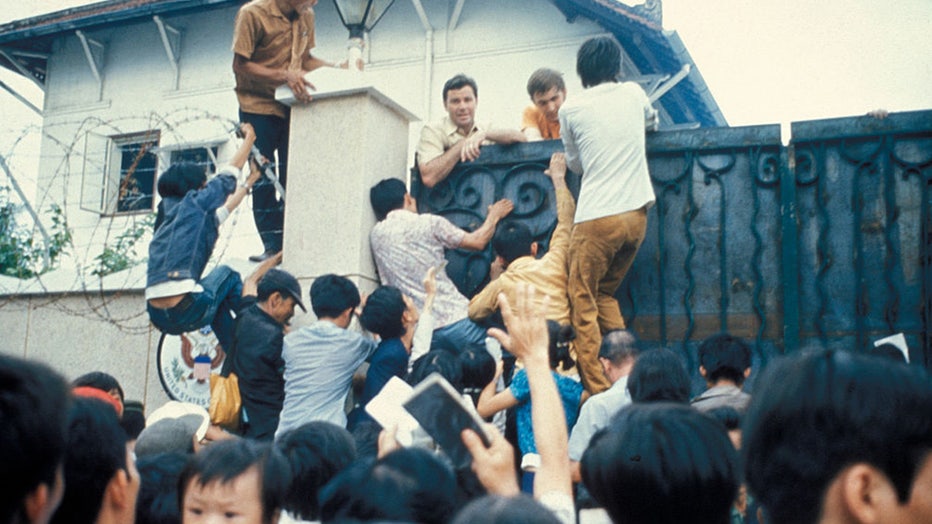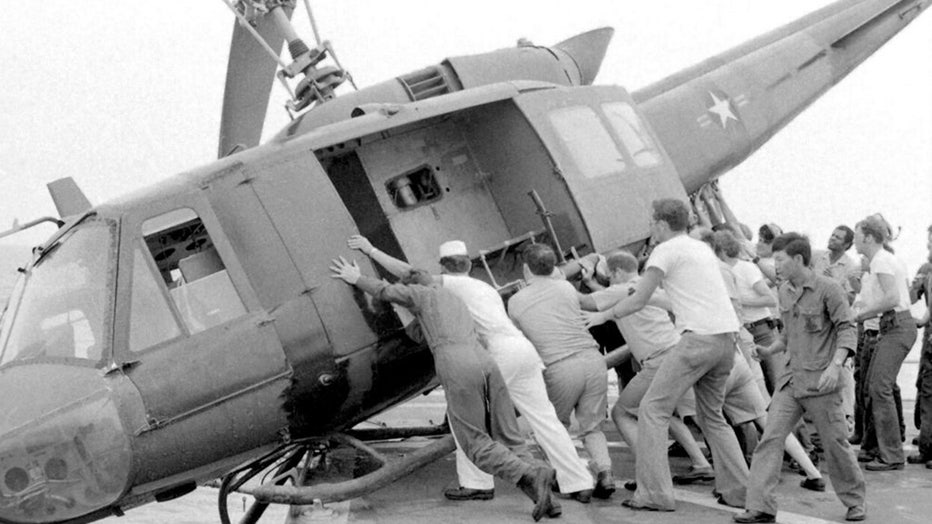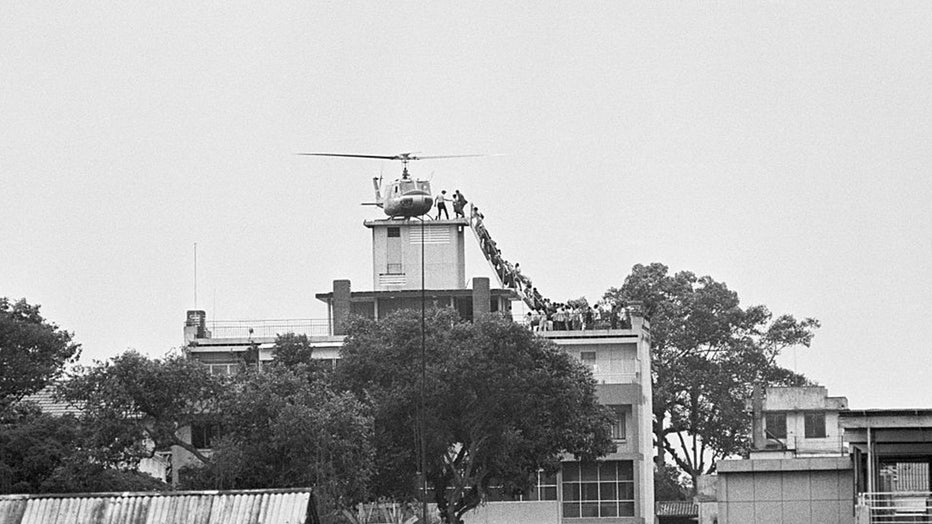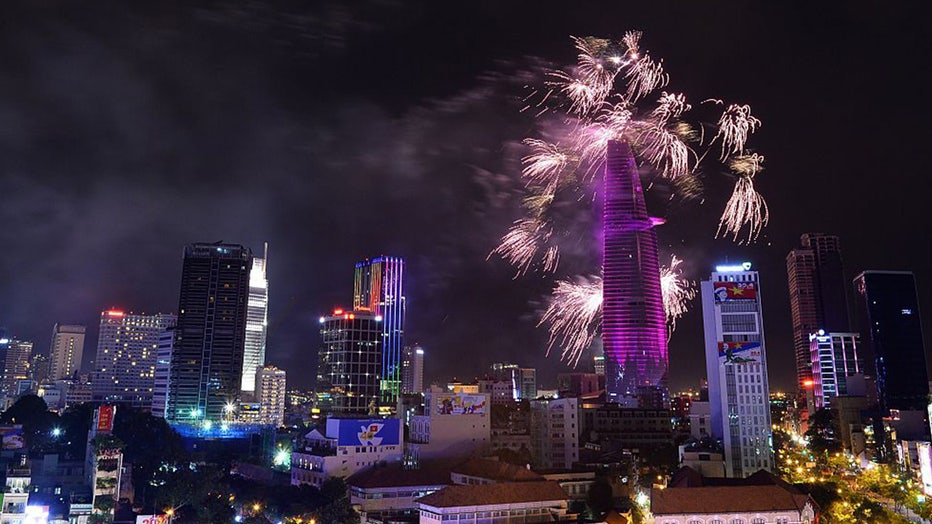What was the fall of Saigon? The end of the Vietnam War, 50 years later

From 1985: Vietnam veterans reflect on war
A decade after the Vietnam War ended, two veterans talk about their experiences during and after the war. Originally reported by Tom Hendrick on May 2, 1985.
The fall of Saigon on April 30, 1975, marked the end of the Vietnam War.
The surrender of South Vietnam ended the decades-long conflict and signaled the reunification of North and South Vietnam. Saigon was renamed Ho Chi Minh City in honor of communist leader Ho Chi Minh.
Take a look at some stats on the war and how it impacted the world 50 years later.
What happened?
The backstory:
On April 30, 1975, North Vietnamese troops took over Saigon, then the capital of South Vietnam. They crashed through the gates of the presidential palace and hoisted the communist flag, marking the end of the Vietnam War.
As North Vietnamese troops shelled Saigon’s Tan Son Njut Air Base, then U.S. Ambassador Graham Martin ordered the evacuation of Saigon, according to the National Museum of American Diplomacy.
To signal all Americans that it was time to evacuate, Armed Forces Radio started playing "White Christmas" on repeat.
Evacuation conditions, however, were less than favorable.
Dig deeper:
Since North Vietnamese troops shelled the airport, it was unusable. People were forced to resort to using helicopters.
Little by little, evacuees were transported from land to U.S. Navy ships 40 miles away in the South China Sea.
Tens of thousands of people, including American and Vietnamese civilians, clamored outside the American embassy gates, hoping to escape the North Vietnamese troops that were closing in.

FILE - Desperate South Vietnamese citizens try to scale the walls of the American Embassy in a vain attempt to flee Saigon and avancing North Vietnamese troops. (nik wheeler/Corbis via Getty Images)
To make room for people aboard ships, helicopters were thrown overboard to lighten the load.

FILE - The Fall of Saigon was the capture of Saigon, the capital of South Vietnam, by the People's Army of Vietnam and the National Liberation Front of South Vietnam (also known as the Viet Cong) on April 30, 1975. (Pictures From History/Universal Im
In their own words
Years after American troops and civilians left Vietnam, reporters, correspondents and diplomats shared their experiences, fears and shame when evacuating Saigon in 1975.
What they're saying:
"The North Vietnamese came south in a wave. It was unbelievable how quickly things happened," Maj. James Kean, an American embassy Marine commander, recalled.
Robert Weiner, a Vietnam correspondent from 1985, said on the day Saigon fell, he felt a sense of happiness but also shame when evacuations were ordered.
"The only way Americans could leave Vietnam was ultimately beating thousands of Vietnamese off the gates of the embassy, off the helicopter," Weiner said.
Robert Hedrix, a civilian pilot who was assisting with evacuations during the fall of Saigon, recalled how families tried to pile into the evacuating helicopters.
"Two of them that I often wonder about were 3-week-old twins that a mother handed me. I was holding them like a couple of fish by the tail. Handed them back to some people behind me, but, you know, I can still see their eyes," Hendrix said.
When did the war start?
The U.S. became involved in the Vietnam War beginning in 1954, but the conflict in the region had stretched back for decades.
Timeline:
Here’s what led up to the war in Vietnam.
1887: France colonizes parts of Southeast Asia, calling it French Indochina, which included Vietnam.
1930: Ho Chi Minh founded the Indochinese Communist Party.
1940: Months after Nazi Germany invaded France, Japanese troops invaded and occupied Vietnam.
1941: Minh and his fellow communists create the League for the Independence of Vietnam, known as Viet Minh. The group aimed to resist the French and Japanese occupation of their country.
1945: Japanese troops carry out a coup and overthrow French authorities and declare Vietnam independent, but a few months later, after being defeated in World War II, Japan leaves the country.
1946: After rejecting a proposal to give Vietnam limited self-government, Viet Minh begins a guerrilla war against the French.
1949: France established Emperor Bao Dai as the head of Vietnam.
1950: After getting backed by the Soviet Union and the newly formed Communist China, The U.S. identifies Viet Minh as a communist threat.
1954: Viet Minh defeats French troops in the Battle of Dien Bien Phu, ending centuries of French rule in Vietnam. The Geneva Accords officially establishes North and South Vietnam.
Despite the treaty, the ultimate goal of both the North and South was to unify Vietnam, but each had a different idea of what that looked like, and thus the civil war continued.
The fighting between North and South only intensified due to the Cold War between the U.S. and the Soviet Union.
What’s more, during President John F. Kennedy’s term, the "Domino Theory" was coined, which suggested that if one Southeast Asian country fell to communism, it would have a domino effect and other countries would follow.
This fear prompted Kennedy to send more U.S. troops to Vietnam, further establishing America’s role in the war despite protests back at home against it.
Infighting between the Viet Cong (Vietnamese Communist) and the South went on for years and eventually ended in April 1975.

FILE - A CIA employee (probably O.B. Harnage) helps Vietnamese evacuees onto an Air America helicopter from the top of 22 Gia Long Street, a half mile from the U.S. Embassy. (Getty Images)
Impact of the Vietnam War in the US
Big picture view:
The Vietnam War greatly impacted U.S. society and culture.
In conjunction with Watergate and the Vietnam War, Americans’ trust in the federal government slumped.
President Richard Nixon, the last president to oversee the war, had ordered a secret bombing campaign in Cambodia, leading Congress to pass the War Powers Resolution.
The resolution restricts the president’s ability to send troops into extended combat without congressional approval, according to the Richard Nixon Presidential Library and Museum.
The war also cemented college campuses as centers of student activism. Protests helped galvanize public opinion that would hasten the withdrawal of U.S. troops and ultimately led to the fall of Saigon.
What's more, the Vietnam War was the first to be televised, giving the world a firsthand glimpse into the horrors of the fighting taking place across the world. Due to this explicit showing of images of people being killed and maimed, many Americans turned against the war.
How many people died during the Vietnam War?
By the numbers:
Some 58,000 Americans were killed in the war along with up to 250,000 South Vietnamese allies and an estimated 3 million communist fighters and civilians.
In all, more than 9 million Americans served, according to a Department of Veterans Affairs blog post.
Ho Chi Minh City today

file - Fireworks light up the sky over the centre of Ho Chi Minh City (former Saigon) late on April 30, 2015 as part of celebrations marking the 40th anniversary of the fall of Saigon. (STR/AFP via Getty Images)
Today, Ho Chi Minh City is alive with capitalism, and many of the scars from the war are no longer visible on the surface.
The city has transformed into a thriving metropolis with glassy high-rises adorned in neon lights, but the old traditions remain.
The city still has generations of families hustling out of small shops to earn money while elderly women peddle the country’s famous pho noodle soup from street stalls.
The relationship between the former enemies has also warmed and grown over the years.
The U.S. normalized relations with Vietnam in 1995. More than 16,000 Vietnamese students now study in America, and the U.S. has become one of Vietnam’s biggest foreign investors.
The Source: Information for this article was taken from reporting by The Associated Press and FOX News. The History Channel contributed and information from the National Museum of American Diplomacy website was used, along with original 1985 TV interviews with people present at the fall of Saigon. This story was reported from Los Angeles.

